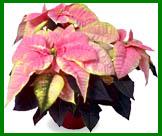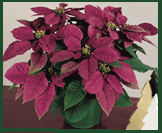How does a plant used by the Aztecs for medicinal purposes and dyes become the quintessential Christmas flower? It began with the legend of the poinsettia. Legend has it that a poor Mexican girl named Pepita had no gift to give at the annual Christmas Eve service. Longing to honor the Virgin Mary and the Christ child, Peptia became distraught as she walked to the service. As tears flow from her face, she was comforted by an angel, her brother or her cousin (depending on the version). At the urging of her comforter, Peptia gathered a handful of common weeds from the roadside. Hesitant to take the unattractive weeds as her gift, Peptia had to be persuaded that giving something perceived as unworthy but from the heart was an admirable gift. Arriving at the church, Peptia sorrowfully placed her weeds as an offering on the alter. Joy overcame her when, as the weeds touch the alter, they burst into stunning red poinsettia blooms. From that day forward the poinsettia was known as Flor de Nochebuena (The Christmas Flower).
History of the Poinsettia
During the late 1820’s, Joel Poinsett was the American Ambassador to Mexico. Although a fine statesman, his passion revolved around botany. During his tenure in Mexico, he scanned the landscape for interesting plants and found the poinsettia. Upon his return to the United States, he introduced the poinsettia to several horticulturists in South Carolina. By the 1900’s, the Ecke Family of South California began producing poinsettias as a landscape plant and a cut flower. Many of the cultivars today are a result work by the Paul Ecke Ranch and the reason the poinsettia has become widely used as a Christmas flower.

Not actually flowers, the big red “blooms” of the poinsettia are actually bracts (modified leaves). The true flowers (cyathia) are the small insignificant yellow clusters in the center of the bract. Despite this misconception, the bract is often referred to as the poinsettia flower. This “flower” has been cultivated into colors other than red such as pink, cream, white, and purple. There are bi-color and marbled poinsettias as well.
Selecting a Poinsettia
Dark green foliage and completely colored bracts are a must when selecting a poinsettia. Optimum poinsettia specimens are full and balanced plants; 2 1/2 times taller than the container and attractive from all sides. Always avoid plants that are wilted, but have moist soil, droopy or yellow leaves all of which indicated the plant is under stress. Look for plants in the early stages of flowering. To find a poinsettia with young true flowers look at the base of the bract. Young true flowers will be green and red-tipped. The poinsettia bract will retain its color longer if you select one with young true flowers.
If the outside temperature is below 50 degrees have the store sleeve your plant. However do not leave the poinsettia in the sleeve for a long period of time. Plants held in decorative paper or sleeves will deteriorate quicker than those in a pot with good drainage.
Poinsettia Care
Keeping the soil moist, but not soggy, is essential when caring for poinsettias. This can be accomplished by watering it thoroughly when the soil is dry to the touch. Make sure the container has drain holes. It is imperative to remove any excess water from the saucer. Poinsettias do best in high humidity with a temperature range of 60 degrees at night and 72 degrees during the day. Avoid exposing poinsettias to temperature swings from cold drafts, heating vents or doorways. Poinsettias need approximately six hours of indirect light. Do not fertilize when the plant is blooming. Temperature swings, over-watering, under-watering, over exposure and lack of light will cause stress to the poinsettia. Stress of any type will cause the bracts to have a shorter life. Poinsettia care if done properly will keep your plant healthy for a long time.
How To Get Poinsettia To Bloom Again
Although getting a poinsettia to re-bloom the next season is a long and arduous process, it is not impossible. Once the holiday season has passed (late February – early March) cut the stems back leaving 4 to 6 inches to stimulate new growth. Continue with the same watering practice used during the holidays and begin fertilizing. Use a balanced (20-20-20) liquid soluble fertilizer every three to four weeks.
Poinsettias need to be re-potted in the late spring or early summer. Select a pot that is 2-3 inches bigger in diameter and has drain holes. Place in a sunny position and keep moist. Rotate the pot about once a week. Rotating encourages a symmetrically shaped plant. Pinch the growing shoots and the top by 1/4 inch to encourage branching. Fertilization and pinching can be done on the same day about every three weeks

Poinsettias can be plant outside once the nighttime temperature is above 50 degrees. Place poinsettia plants in a shady location for about two weeks to acclimate them to the outdoors. Poinsettias can be planted in a sunny but protect area; light shade in the afternoon is acceptable.
In early September move the poinsettia plants indoors and provide six hours of direct light. Poinsettia flowering is “photoperiodcally” induced, meaning flowers begin to appear when the nights are long enough. Hence the poinsettia needs a certain amount of darkness to bloom. From October 1st through mid-December, poinsettias must have 12-14 hours of darkness and 10-12 hours of natural light daily. Complete darkness is imperative to blooming. Once the bract begins to show color the light restrictions are less important and the original poinsettia care begins again.

Florists know how important poinsettias are to the Christmas holidays. After all without an ornately decorated tree, a wreath and the Christmas flower (poinsettia) to adorn our homes the feeling of Christmas just wouldn’t be the same. Whether pink, white, purple or red, the poinsettia is the perfect flower for Christmas. Explore the poinsettia colors at your local florist today.
Send someone a poinsettia today!
Learning more about Poinsettia Trends on the Bloomin’ Blog.
Got plant or poinsettia questions? Ask the Expert at the Bloomin’ Blog.



